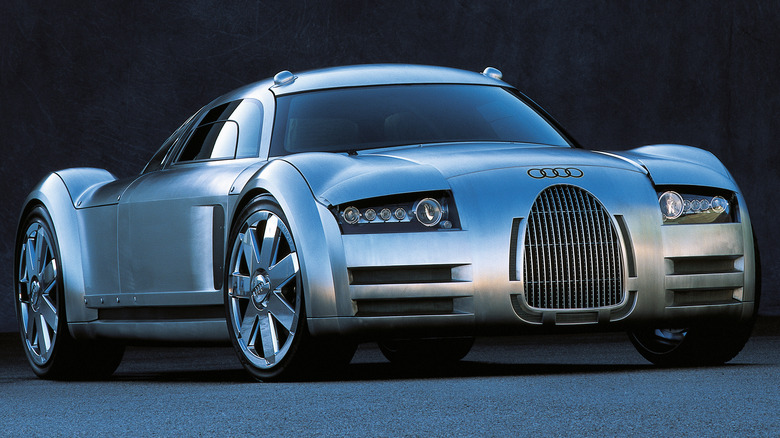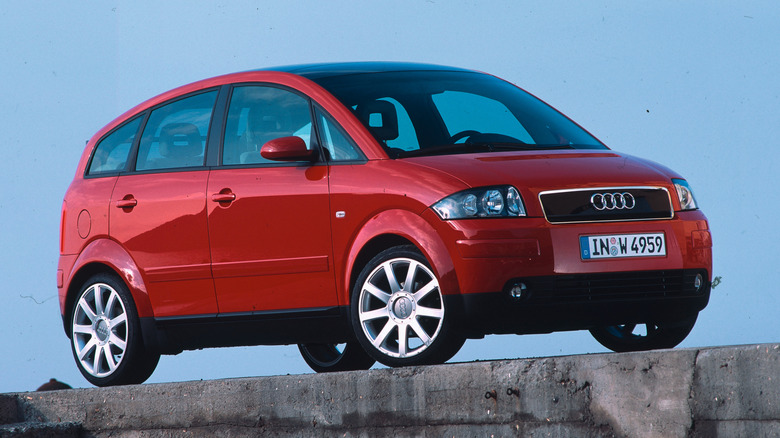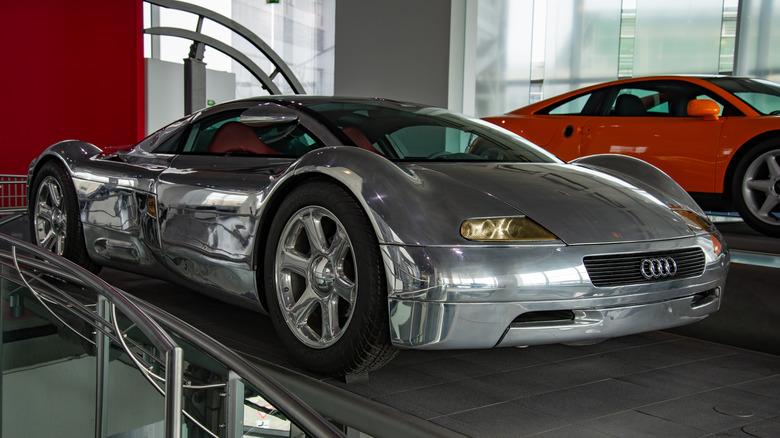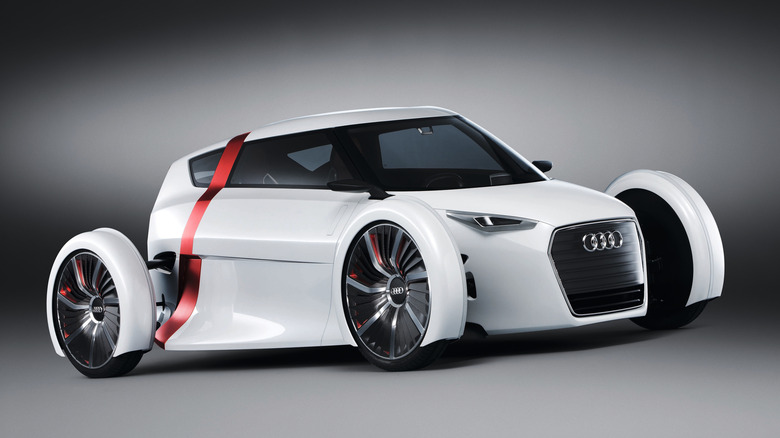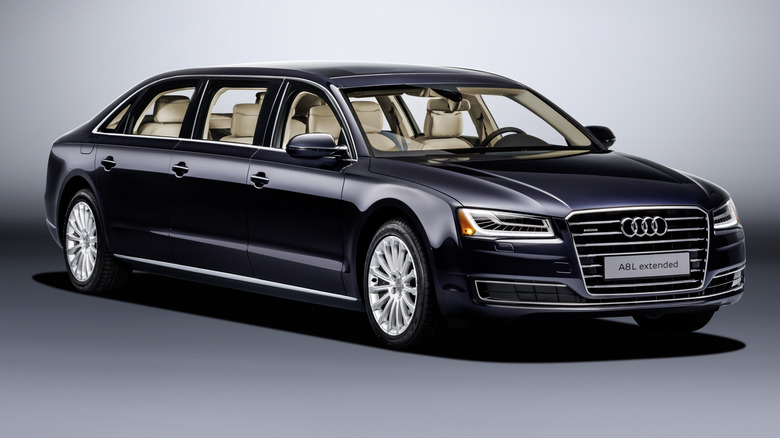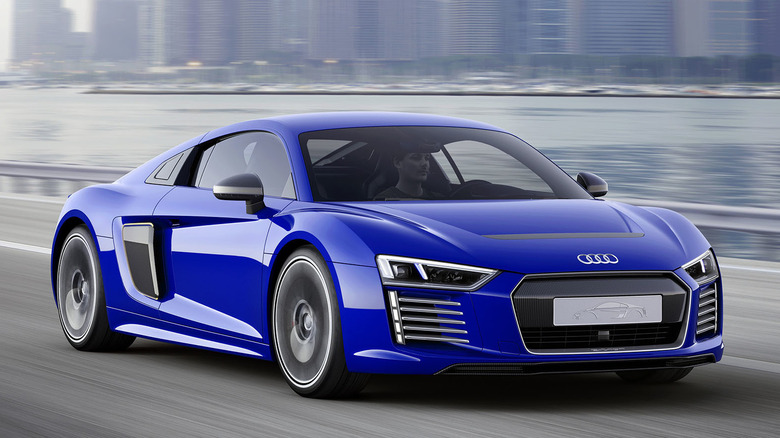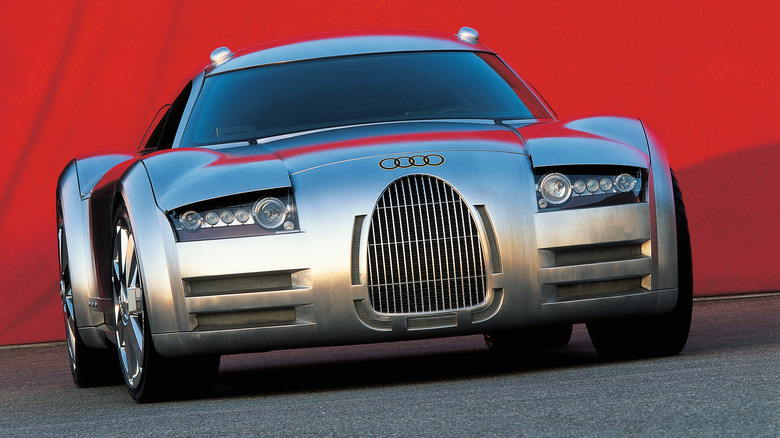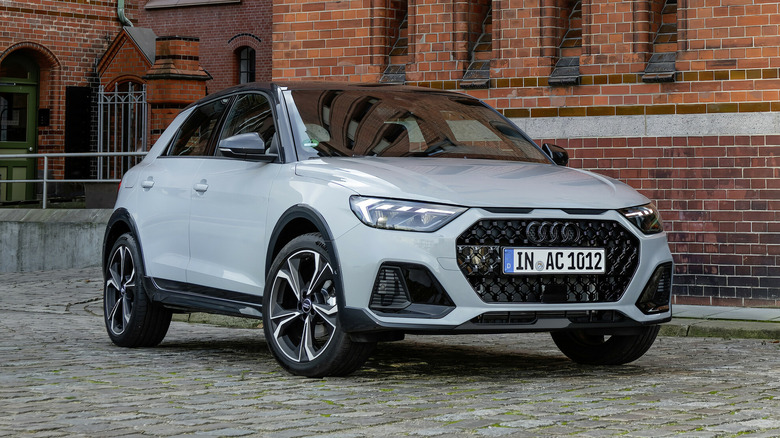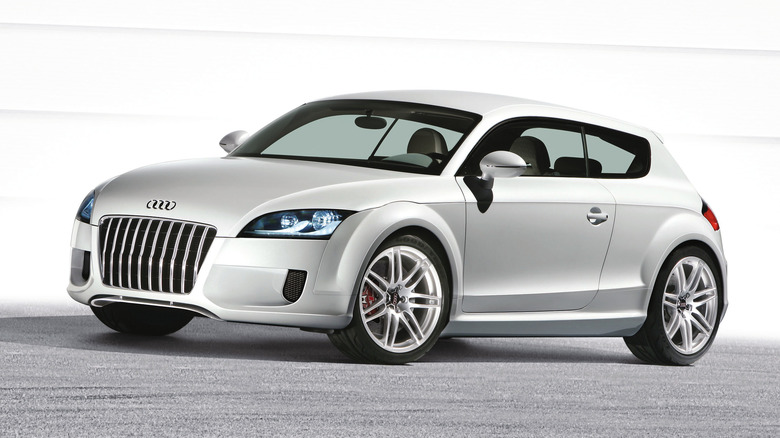8 Of The Strangest Cars Ever Built By Audi
Although Audi can trace its history back to 1899, the company as most people would know it was truly founded in 1932, when its iconic four-ring logo was chosen to represent the four automakers that merged to form the company. Initially known as Auto Union, Audi has built up a reputation over the decades as a creator of innovative premium cars, eventually joining the VW Group in 1964, which it remains part of today. The brand's back catalog includes plenty of performance greats like the Quattro, RS2 Avant, and the more recent R8. Alongside these icons, plenty of strange and unusual Audis have managed to slip under most enthusiasts' radars.
Among them is the predecessor to one of the most groundbreaking supercars in modern history, a canceled electric city car with a four-figure price tag, and a prototype with a wooden engine. Here, we've rounded up eight of the strangest production cars, prototypes, and concepts from Audi's past and present, many of which remain forgotten by all but the brand's most dedicated enthusiasts.
Audi A2
The A2 might be one of the strangest looking superminis of its era, but there was solid reasoning behind its design. The tall, curved shape of the car was designed for maximum aerodynamic compliance, with a drag coefficient of just 0.28. Combined with its light curb weight, this made it an exceptionally frugal option, with the diesel variant of the car achieving nearly 70 mpg. The car was one of the first to be made with aluminum alloy, a key factor in Audi being able to keep the weight so low, and one that makes it tricky to repair today.
It was only ever sold in Europe, although the first examples of the A2 were manufactured in 1999, so they're just starting to become old enough to be imported Stateside under the 25-year rule. However, actually finding one to import might not be so easy. Thanks to their unusual shape and high price when new, the A2 never sold as well as Audi had hoped. The car has escaped "cult classic" status, at least for now, and most surviving examples can be picked up for the equivalent of a few thousand U.S. dollars.
Audi Avus Quattro
Long before the Audi R8 became the brand's first production supercar, the Avus Quattro previewed what was in store at the Tokyo Motor Show in 1991. Its bodywork was made from aluminum — a novel idea at the time, but one that would become commonplace on Audi's production cars over the following decades. The car sported a mid-mounted W12 engine with officially quoted stats of 509 horsepower and a 211 mph top speed. However, there was one major flaw with those numbers: they were entirely made up.
The engine that was supposed to power the Avus Quattro was running behind in development and, as a result, missed the deadline for the opening of the big show. The replacement "engine" visible from the rear of the concept is actually a wooden mockup, and the car's performance figures were estimates based on what Audi thought the real engine would be capable of when finished. The Avus Quattro never made it to production, but the W12 engine it was supposed to house would eventually feature in the A8 sedan.
Audi Urban Concept
The Urban Concept might look like just another show car, but at one point, it seems Audi was quite serious about putting it into production. Two versions of the car were built: a stylised variant painted bright white that was shown off at the 2011 Frankfurt Motor Show, and a fully functional yellow prototype that was driven by the folks at Car Magazine a few months later. It was, in essence, a sort of road-oriented electric go-kart designed as an urban runabout, with a range of just 30 miles and a top speed of around 60 mph.
Car Magazine's review claimed that Audi was planning to launch a limited production run of 999 examples at a price of €9,999 each, with a tentative launch window of 2013. For unknown reasons, the project was shelved, and no similar successor emerged. The concept was reported at the time to be part of Audi's upcoming range of electric vehicles, but as the market has shifted to favor larger, high-riding SUVs and crossovers, it's possible that Audi simply didn't see a way to make the Urban Concept a financially viable model.
Audi A8L Extended
It might look like a Photoshop job at first glance, but the Audi A8L Extended is actually a one-off production car built for a wealthy European client. Strangely enough, it's powered by a V6 engine, the base-spec option for the A8 range. That provides a relatively modest 310 horsepower and 325 lb-ft of torque, a far cry from the figures on offer with the A8's range-topping W12 engine option.
Although it was originally meant to be a singular vehicle, Audi reportedly received several more requests for elongated A8 limousines after news of the first one broke in 2016, and it's not clear how many have been produced in total. It's also not clear why any deep-pocketed shoppers looking for the ultimate luxury limousine wouldn't head over to VW Group stablemate Bentley, rather than badger Audi for a longer version of its priciest executive sedan. But hey, anyone with one-off limousine money doesn't need to play by the usual rules.
Audi R8 e-tron Piloted Driving
One of the key elements of owning a supercar is the thrill of driving it, be that on a closed track or on winding open roads. Taking that element out of any supercar seems counterintuitive, but that's exactly what Audi did with the R8 e-tron Piloted Driving model. Designed as a technological showcase to highlight the brand's autonomous driving tech, the car was made to drive itself using a series of sensors and scanners, without any input needed from the driver.
While the self-driving tech was, at the time, highly impressive, fitting it to an R8 seemed like a strange move. Autonomous tech is arguably at its most appealing when it can replace the monotony of the daily commute or the hassle of driving in bigger cities, and Audi has plenty of cars designed for those tasks. The A8 flagship sedan would arguably have been a great candidate for self-driving tech, as plenty of A8 owners are likely to prefer being chauffeured over driving themselves. But taking Audi's best drivers' car and taking the driving element out of it? Even as just a design showcase, it seems almost blasphemous.
Audi Rosemeyer
It's strange to think that the record-breaking Bugatti Veyron could have been an Audi had things turned out just a little differently in the early noughties. The Rosemeyer prototype of 2000 was the direct predecessor to the Veyron, with the same W16 engine and an equally slippery shape to maximize aerodynamics. That shape was in turn inspired by the classic Auto Union race cars of the 1930s. Many fundamentals are shared with the Bugatti, but the 700 horsepower on offer with the Rosemeyer is somewhat short of the Veyron's four-figure total. Nonetheless, it's still enough to propel the car to an estimated top speed of over 217 mph.
This wasn't the first experimental hypercar with Veyron DNA, as Bentley had unveiled its own W16 prototype a year earlier. In the end, both the Audi and the Bentley remained as one-offs, with VW Group bosses deciding to launch the upcoming hypercar under the Bugatti name instead. Many of the styling cues were carried over, though: Just picture the car with a smaller front grille and lower roofline, then look at the Bugatti Veyron. At least from the front, the Veyron has more than a hint of the Audi about it, even if the Veyron's styling has arguably aged a lot more gracefully than its German predecessor.
Audi A1 Allstreet
The trend of rugged-ized passenger cars is nothing new, but the Audi A1 Allstreet (formerly sold as the Citycarver) takes things to new levels of silliness. It takes the pint-sized A1 hatchback and lifts it by nearly two inches, then adds beefier tires and some plastic cladding to the wheel arches. Two powertrain options are available, with the base-spec three-cylinder engine making just 95 horsepower and the turbocharged four-cylinder managing a more reasonable 150 horsepower.
It was discontinued in some markets due to a lack of demand in 2022, but continues to be sold in continental Europe for now. It's not hard to see why it was a sales flop: Taking a city car and dressing it up with off-road inspired bits was never going to sway many buyers, especially since the regular A1 is about as far away from "rugged" as it's possible to get.
It might only limp on in a handful of markets, but as long as it's around, the Audi A1 Allstreet wins the unenviable title of Audi's strangest current production car by a decent margin.
Audi Shooting Brake Concept
The 2005 Shooting Brake Concept saw Audi take the TT and turn it into a proper four-seater, complete with a high enough roofline at the rear to comfortably seat four adults. The shooting brake sports car design was unlike anything else on the market at the time, but Audi eventually decided there was no market for such a car and it remained as a concept only. However, if it had been given the green light for production, relatively few changes to the regular TT would have been required.
The standard 3.2L six-cylinder engine was retained for this model, along with Audi's four-wheel drive Quattro system. Most of the other oily bits remained untouched. The concept was fully functional and sported an electronically limited top speed of 155 mph, with a 0-62 mph time of around six seconds. Pretty standard sports car territory, in other words. Unfortunately, Audi's unusually-styled TT never made it to dealerships — and after 2023, the regular TT will also be consigned to the archives.
